博文
10月23日iCANX第28期┃光学新星照亮世界!
|||
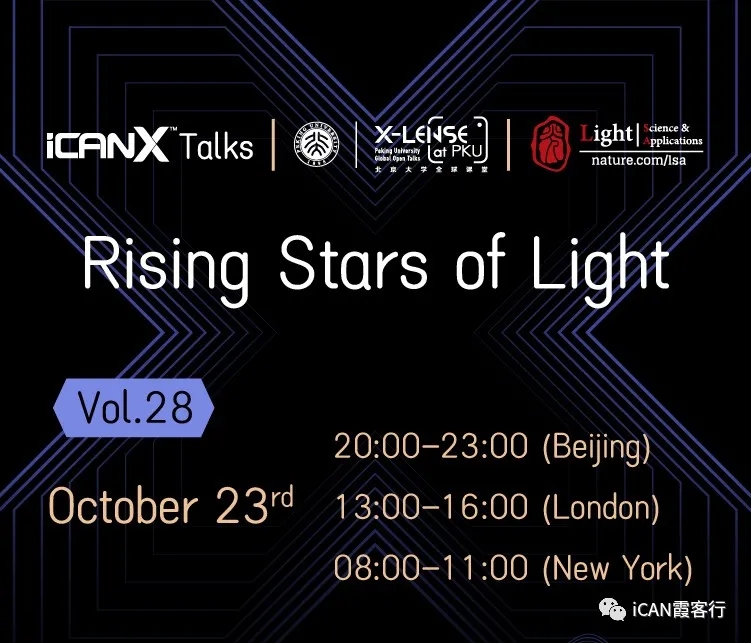
北京时间10月23日晚8点,大家期待已久的 iCANX Talks第二十八期即将重磅来袭,本期直播将迎来世界顶尖光学期刊Light: Science & Applications与iCANX Talks联合发起的Light学术新星评选活动,从7月份正式发出通知,共有世界各地的35位优秀青年科学家获得提名,经过严格的筛选最终有10位杰出的青年科学家入围最终的角逐,他们将在23日和30日的iCANX Talks上进行最终的评选,每人做20分钟的演讲,并接受5位世界顶级光学专家组成的评审团的提问和评议。
五位评委分别是来自加利福尼亚大学洛杉矶分校的Aydogan Ozcan教授、原科技部副部长曹健林、澳大利亚国立大学的Chennupati Jagadish教授、纽约市立大学的Andrea Alù教授、以及来自西湖大学的仇旻教授。本次Light学术新星评选活动设有1名一等奖,2名二等奖和3名三等奖,最终的比赛结果将在30日的iCANX Talks上揭晓。
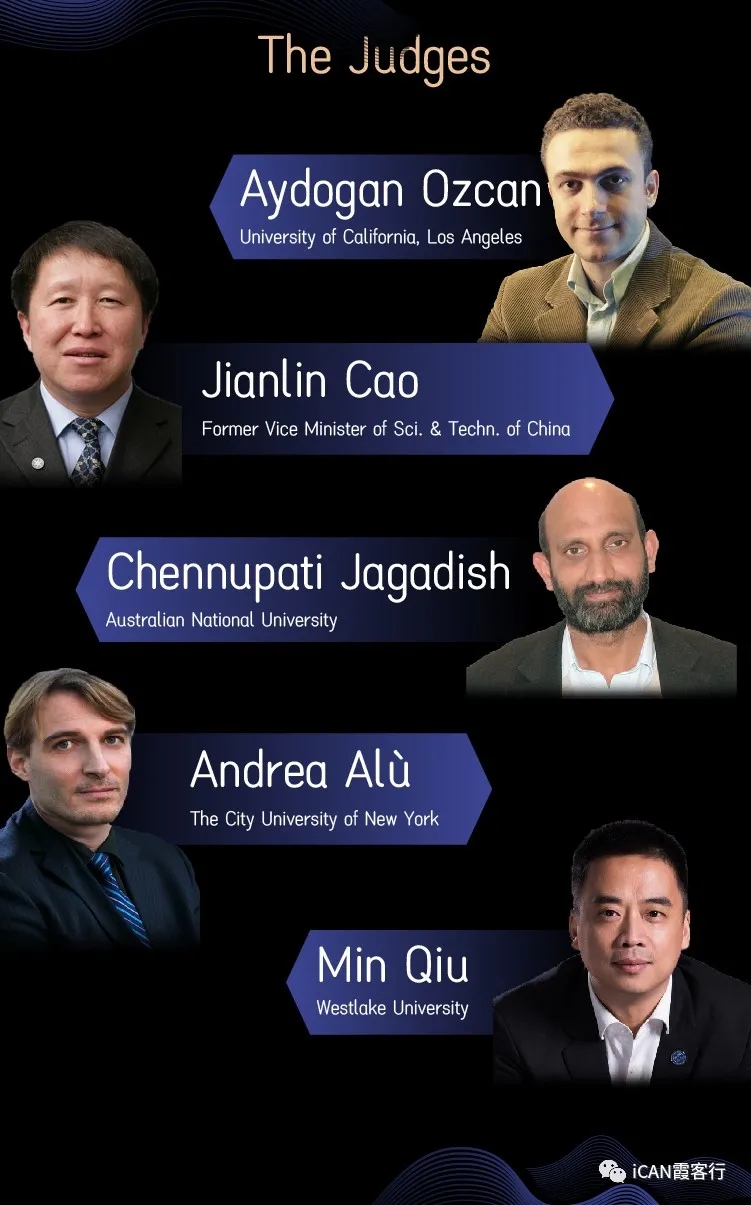
本周率先即将登场的5位青年科学家是:来自科罗拉多大学博尔德分校孙硕教授、复旦大学的孙树林教授、美国范德堡大学的Justus Ndukaife教授、新加坡国立大学的胡光维博士、以及来自斯坦福大学的Avik Dutt。他们将在iCANX Talks的舞台上给大家带来一场精彩的学术竞赛。
在前27期的iCANXTalks直播中,累计收看观众已经近千万人次,受到了国内外专家学者的普遍好评和追捧,目前,iCANXTalks已经成为极具国际影响力的高科技云端学术峰会。
话不多说,先让小艾给大家详细介绍五位青年科学家和他们的演讲内容吧!
报告1
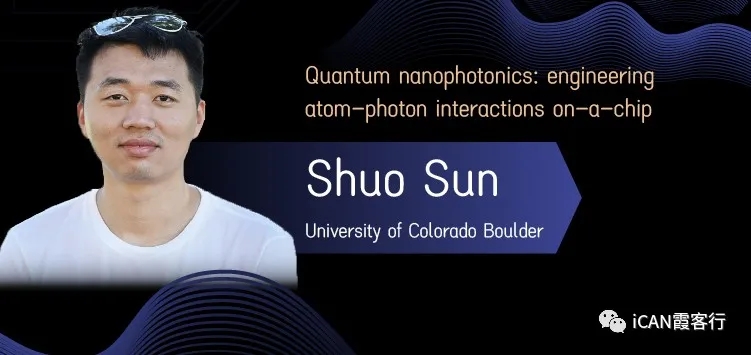
Quantum nanophotonics: engineering atom-photon interactions on-a-chip
量子纳米光子学:在芯片上产生与调控原子与光子的相互作用
Shuo Sun
孙硕
University of Colorado Boulder
科罗拉多大学博尔德分校
Abstract
The ability to engineer controllable atom-photon interactions is at the heart of quantum optics and quantum information processing. In this talk, I will introduce a nanophotonic platform for engineering strong atom-photon interactions on a semiconductor chip. I will first discuss an experimental demonstration of a spin-photon quantum switch [1], a fundamental building block for quantum repeaters and quantum networks. The device allows a single spin trapped inside a semiconductor quantum dot to switch a single photon, and vice versa, a single photon to flip the spin. I will discuss how the spin-photon quantum transistor realizes optical nonlinearity at the fundamental single quantum level, where a single photon could switch the transmission of multiple subsequent photons [2]. Toward the end of this talk, I will highlight exciting applications of these devices in quantum networks and optical quantum information processing.
产生与调控原子和光子的相互作用是量子光学和量子信息处理的核心。在这次的讲座中,我将介绍一种利用纳米光学手段在半导体芯片上实现强原子光子相互作用的器件平台。首先,我将讨论我们实验上实现的耦合电子自旋和光子的量子开关。该量子开关可以利用单个电子的自旋态控制光子的偏振态,同时利用单个光子的偏振态控制电子的自旋,因而被视为量子中继器和量子网络的基础组件。我将接下来介绍我们如何利用这个器件实现单光子尺度的光学非线性现象。讲座的最后,我将阐述这些器件在量子网络和光量子信息领域的广泛应用前景。
Biography
Shuo Sun is an associate fellow of JILA and an assistant professor of Physics at the University of Colorado Boulder. He is an expert in quantum optics, nanophotonics, and optical quantum information science. Dr. Sun obtained his BS in 2011 from Zhejiang University, China, and obtained his PhD in 2016 from the University of Maryland, College park. During his PhD, he developed the first spin-photon quantum switch and the first single-photon transistor using a solid-state spin. His pioneering research achievements have been awarded by the Maiman grand prize from the Optical Society of America and the Distinguished Dissertation Award from the University of Maryland, College Park. Before joining the faculty of JILA and the University of Colorado Boulder in 2020, Dr. Sun was a postdoctoral fellow (2017 – 2019) and a physical science research scientist (2019 – 2020) in the Ginzton Lab of Stanford University. There he worked with Prof. Jelena Vuckovic on color center based quantum optics and inverse designed quantum photonics. Dr. Sun has published more than 20 journal articles and book chapters. He is an assistant topical editor of JOSA B, and a regular reviewer of 19 journals including Nature, Nature Nanotechnology, Nature Physics and PRL.
孙硕目前任职于科罗拉多大学博尔德分校,担任物理系助理教授以及JILA Associate Fellow. 他是量子光学,纳米光子学,以及光量子信息领域的杰出研究者。孙硕于2011年取得浙江大学光电信息工程系学士学位,2016年于马里兰大学帕克分校取得电子工程博士学位。在就读博士期间,他开发了首个基于固态电子自旋的光量子开关以及单光子调控的光学放大器。他的研究获得了美国光学学会颁发的Maiman学生论文奖以及马里兰大学电子工程系的杰出毕业论文奖。在加入科罗拉多大学之前,孙硕在斯坦福大学Ginzton Lab先后担任博士后(2017-2019)和研究科学家(2019-2020)职位。在斯坦福大学期间,他在Jelena Vuckovic研究组研究基于色心的量子光学以及基于目标优先设计的量子光学器件。孙硕博士迄今已发表论文和书刊章节超过20篇。他目前是美国光学学会期刊JOSA B的助理编辑,同时是包括Nature, Nature Nanotechnology, Nature Physics, PRL在内的19个期刊的审稿人。
报告2
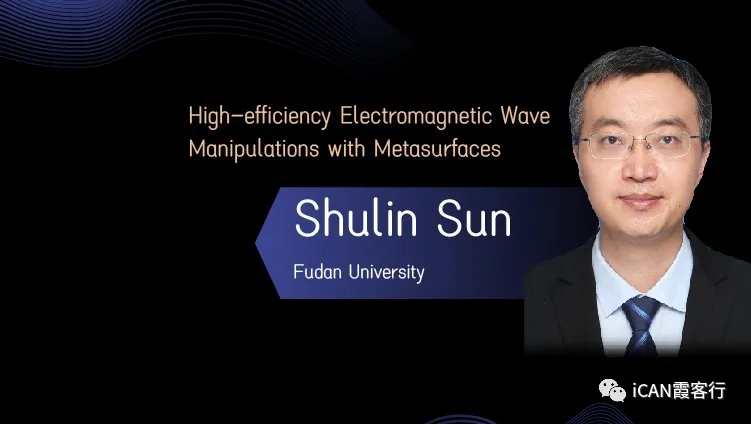
High-efficiency Electromagnetic Wave Manipulations with Metasurfaces
超构表面高效率调控电磁波
Shulin Sun
孙树林
Fudan University
复旦大学
Abstract
Manipulating electromagnetic (EM) waves in desired manners are important for both sciences and applications. However, naturally existing materials exhibit limited capabilities on EM wave controls. Metamaterials, man-made materials consisting of subwavelength microstructures (also called as meta-atoms) arranged in certain macroscopic orders, were recently proposed that can exhibit many fascinating wave-manipulation effects, including negative refraction, super lens, and optical cloaking. However, after decades of development, researches on bulky metamaterials face several challenges, such as complicated fabrication, increasing energy loss. In particular, one important freedom, i.e., the arrangement order of meta-atoms inside bulky metamaterials, was difficult to be fully exploited due to the structural complexity. Facing these challenges, our group proposed to design ultrathin metasurfaces (or two-dimensional version of metamaterials) to efficiently manipulate EM waves. Different from conventional bulky optical elements (including metamaterials) replying on the accumulation of propagating phases for wave manipulations, the metasurfaces can introduce abrupt change of EM phases and thus modulate the imping light, which can be usually ultra-thin, low-loss, and easy for optical integration. The freedoms to manipulate EM waves are also significantly expanded with such two-dimensional systems. Here, I will focus on our works on high-efficiency EM wave controls, including surface wave manipulations and spin-dependent wave manipulations.
自由调控电磁波对于基础科学和实际应用均具有重要意义,然而自然材料对电磁波的调控能力受到极大限制。超构材料是一种由亚波长微结构(或称人工原子)按照某种宏观排列方式组成的“人工材料”,它对电磁波展现出众多新奇的调控效应,包括负折射、超透镜、光学隐身等。然而,经过数十年发展,超构材料领域的相关研究面临巨大的挑战,例如制备难、损耗高等。特别是三维超构材料的结构复杂性导致其排列方式这一重要自由度难以被充分利用。面对这些挑战,我们团队提出了利用超构表面高效率调控电磁波的新概念。不同于体式光学器件(包括超构材料)依赖传输相位积累调控电磁波的思想,超构表面是通过引入界面相位突变来调控入射波,具有体系薄、损耗低、易于光学集成等优势。基于这类两维体系,调控电磁波的自由度可被极大拓展。本次报告将主要介绍本团队在高效率表面波调控方面的工作,包括表面波调控和自旋依赖电磁调控等。
Biography
Shulin Sun received his Ph. D. degree in Physics at Fudan University in 2009. From 2010 to 2013, he was a Postdoctoral Fellow of the Physics Division of National Center for Theoretical Sciences (NCTS) at National Taiwan University. In 2013, he joined the Department of Optical Science & Engineering at Fudan University, and has been a full Professor and associate head of the department since 2019. He has been in the research fields of metamaterials/metasurfaces, plasmonics and photonic crystals, and published over 60 papers in scientific journals including Nature Materials, Nano Letters, Advances in Optics and Photonics, Light: Science and Applications, etc. The total citation is over 4800 times with the highest one being over 1200 times (google scholar). He won the Second Prize of National Natural Science Award in 2019 (ranked No. 2), the First Prize of Shanghai Natural Science Award in 2016 (ranked No. 2), the Prize of Important Optical Achievements of China in 2012 (ranked No. 1), and Outstanding Paper Award of Light: Science and Applications in 2018 (Corresponding Author).
孙树林,2009年在复旦大学物理学系获得博士学位,2010至2013年在台湾大学物理系任博士后研究员,2013年入职复旦大学光科学与工程系,2019年起任研究员、系副主任。研究方向包括电磁超构材料/超构表面、纳米光子学、光学微腔等,目前已发表论文60余篇,包括Nature Materials, Nano Letters, Advances in Optics and Photonics, Light: Science & Applications等期刊论文,被引用4800余次,单篇最高引用1200余次(谷歌索引)。曾获“2019国家自然科学二等奖”(第二完成人),“2016上海市自然科学一等奖”(第二完成人),“2012中国光学重要成果奖”(第一完成人),“2018 Light: Science & Applications杰出论文奖”(通讯作者)等奖项。
报告3

Opto-Thermo-Electrohydrodynamic Tweezers: A New Tool for Biology and Medicine
光-热-电流体力学镊子:生物和医学的新工具
Justus Ndukaife
Vanderbilt University, USA
美国范德堡大学
Abstract
One-half of the 2018 Nobel Prize in Physics was awarded for Optical Tweezers and their application in biological systems. Optical tweezers have emerged as a powerful tool for the non-invasive trapping and manipulation of colloidal particles and biological cells. However, the stable trapping of nanometer-scale biological objects such as proteins, DNA, exosomes, and virions has been met with challenges due to the diffraction limit of light. Attempts to substantially increase the laser power to generate enough optical trapping potential for trapping such small biological objects, unfortunately, results in photo-toxicity and thermal stress, which damages the integrity of the biological specimens. An optical nanotweezer approach that can stably trap nanoscale biological objects without exposing them to high light intensity or heat which may physically alter or destroy detectable bio-activity is of paramount importance for fundamental life science research and translational biomedical applications. In this talk, I will introduce a new kind of optically controlled nanotweezers termed Opto-ThermoElectrohydrodynamic Tweezers (OTET) that enables the stable trapping and dynamic manipulation of sub-10 nm biomolecules at locations that are several microns away from the high-intensity laser focus, where they experience both negligible photothermal heating and light intensity. The OTET platform employs a finite array of plasmonic nanoholes illuminated with light in conjunction with an applied alternating current electric field to create the spatially varying electrohydrodynamic potential that can rapidly trap sub-10 nm biomolecules at femtomolar concentrations on-demand. This novel noninvasive optical nanotweezer is expected to open new horizons in life science and medicine by offering an unprecedented level of control of tiny nano-sized biological objects in solution without photo-induced damage.
2018年的诺贝尔物理学奖,有一半授予了光镊及其在生物系统中的应用。目前,光镊已经成为非侵入式捕获和操纵胶体颗粒以及生物细胞的强有力工具。然而,由于光的衍射极限,蛋白质、DNA、外来体和病毒颗粒等纳米尺度生物目标的稳定捕获一直面临着困难。虽然通过大幅增强激光能量,可以产生更强的捕获能力,但这样却会引发光毒性和热应力,从而破坏生物标本的完整性。因此,我们亟需一种可以稳定捕获纳米尺度生物样本,而不将其暴露在可能破坏生物活性的高光强或高温下的纳米光镊方法。在本报告中,我将介绍一种新的纳米光镊,即光-热-电流体力学镊子(OTET),它能够稳定地捕获和动态操纵小于10纳米的生物分子,这些生物分子被放置于离高强度激光焦点几微米以外的地方,因此光热效应和光强对生物活性的影响可以忽略不计。OTET平台采用有限的等离激元纳米孔阵列,在光和外加交流电场的作用下,产生空间变化的电流体动力学势,可根据需要快速捕获小于10纳米的生物分子。这种新型的非侵入性纳米光镊可以在不引起光致损伤的情况下为微小纳米生物体提供前所未有的控制水平,有望在生命科学和医学领域开辟新的天地。
Biography
Justus Ndukaife is an assistant professor of electrical engineering at Vanderbilt University, USA. He received a Ph.D. in Electrical Engineering from Purdue University, USA in 2017.
Ndukaife’s interdisciplinary research is focused on nanophotonics for biomedical applications. He has made major contributions to the field optical nanotweezers. Very recently, Ndukaife invented a new optical nanotweezer approach termed: “opto-thermoelectrohydrodynamic tweezer (OTET)” that enables the trapping of sub-10 nm size biological molecules at tunable trapping locations several microns away from the highintensity focus to prevent the issue of photo-induced damage usually encountered when trying to trap such minuscule objects using the conventional optical tweezer technology that was recognized with one-half of the 2018 Physics Nobel Prize. Ndukaife’s research works have been published in the top peer-reviewed journals including Nature Nanotechnology, Science, ACS Nano, and Nano Letters, and he is an inventor of six technologies relating to optical nanotweezers. In recognition of his scientific contributions, Ndukaife received the Year 2017 Prize in Physics by the Dimitris N. Chorafas Foundation. His other honors include the Purdue College of Engineering Outstanding Research Award, NSBE Golden Torch Award, Best Paper Award at the ASME conference, Carnegie African Diaspora Fellowship Award, and Vanderbilt Provost Research Studios Award.
Justus Ndukaife于2017年获得美国普渡大学电气工程博士学位,现任美国范德堡大学电气工程系的助理教授。Ndukaife的研究横跨多个学科,主要集中在具有生物医学应用的纳米光子学上。他在纳米光镊领域做出了重要贡献。我们都知道,传统的光镊技术已经在2018年赢得了诺奖,但是其未能解决使用高强度激光对生物分子的损伤问题。最近,Ndukaife发明了一种新的纳米光镊方法,称为“光-热-电流体力学镊子(OTET)”,它能够在距离高强度激光焦点几微米外的位置捕获或操控小于10纳米的生物分子,因此可以防止光致损伤问题。Ndukaife的研究成果在包括Nature Nanotechnology、Science、ACS Nano和Nano Letters在内的顶级期刊上发表,同时,他是纳米光镊相关的六项技术的发明人。Ndukaife因其科学贡献获得了Dimitris N. Chorafas基金会颁发的2017年物理学奖。同时,他还荣获包括普渡工程学院杰出研究奖、NSBE金火炬奖、ASME会议最佳论文奖、卡内基非洲侨民奖学金和范德堡教务长研究工作室奖。
报告4
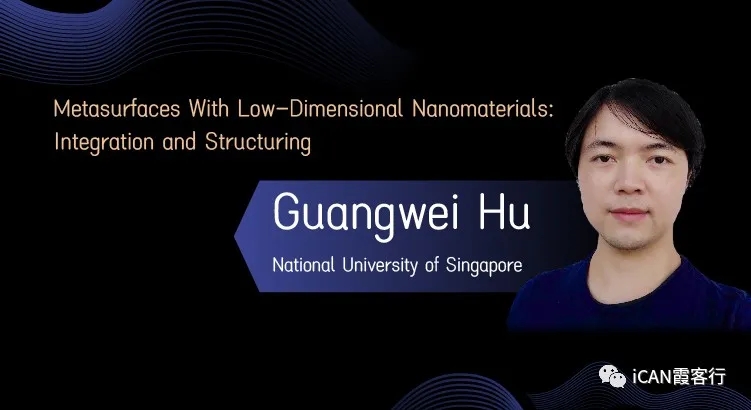
Metasurfaces With Low-Dimensional Nanomaterials: Integration and Structuring
当超构表面遇到低维纳米材料:集成与结构化
Guangwei Hu
胡光维
National University of Singapore
新加坡国立大学
Abstract
“God made the bulk; surfaces were invented by the devil.” Quoted from Wolfgang Pauli. In last two decades, two kinds of surfaces, i.e. metasurfaces (“2D metamaterials”) and low-dimensional nanomaterials (2D materials), emerge and support the extreme manipulation of light within an ultrathin and highly compact platform. However, the development of metasurface reaches a stage where all conventional materials (dielectrics, metals etc) have nearly been exhausted. While 2D nanomaterials presents exotic properties, they are too thin to be practically useful (Chemical Reviews, 2020). In this talk, I will show you how we can develop advanced metaphotonics by combining those two “devil-invented” surfaces, via our proposed two important strategies: integration and structuring. Specifically, I will provide a case study of integrating a monolayer semiconductor with a linear metasurface to develop the coherent nonlinear and valleytronic devices (Nature photonics, 2019), which are allowed by either metasurfaces or 2D materials alone. Besides, through structuring low-dimensional nanomaterials with a twisted stack, we achieved extreme dispersion engineering and “magic-angle” topological transitions of plasmon (Nano Letters, 2020) and phonon polaritons (Nature, 2020; Nature Communications, 2020). This work, for the first time, has transformed the so-called twistronics (i.e. engineering electron’s bandstructures of interlayer-coupled twisted 2D materials in condensed matter physics) into photonic regime and developed the new field of “opto-twistronics”. Via the proposed systematic strategies of integration and structuring, the advanced valleytronic, nonlinear, polaritonic and opto-twistronic applications may be developed.
“上帝创造了体,但是表面却是由魔鬼发明的” (语自:沃尔夫冈·泡利)。过去二十年间,有两种“表面”材料兴起,分别是超构表面和二维材料,他们可以被制成超薄超集成器件并对电磁波实现极端操控。然而,超构表面领域几乎已经探索了所有可能的传统材料,包括金属和介质等。同时,二维材料尽管有各种新奇光电性能,但是由于太薄而无法在光波段被有效利用。这里,我将提出使用集成与结构化的两个策略,将这两种“魔鬼般”的表面材料结合,发展出新的超构光子学。具体来说,我将展示将线性超构表面和二维半导体集成,实现非线性和能谷器件。同时,将低维材料结构化或加以旋转,我们首次实现了低维材料等离子和声子极化激元的极端传播与拓扑调控;这一发现将凝聚态物理中兴起的“转角电子学”发展到光学领域。所提出的集成和结构化这两种系统的方法,有望助力新的能谷学,非线性光学,极化激元和“转角光子学”的发展和应用。
Biography
Mr. Guangwei Hu was born in 1994. He received the B. Sc. in Harbin Institute of Technologies in 2016 and is the PhD student in National University of Singapore from Sept. 2016 to Oct. 2020. His current research interests include fundamental light-matter interactions of metasurface and low-dimensional nanomaterials, with promising applications, such as the multifunctional metadevices, the optical engineering of the 2D materials, polaritonics (plasmon, phonon and excitons), and topological transitions in photonics, among many others. He has co-authored more than 20 papers in many journals including Nature, Nature Photonics, Light: Science & Applications, Nature Communications, Science Advances, Chemical Reviews, Nano Letters, Advanced Materials, and more others. He received NUS Research Scholarships, President's Graduate Fellowships and Chinese government award for outstanding self-finance students abroad.
胡光维于2016年在哈尔滨工业大学获得本科学位,2016年9月至2020年10月于新加坡国立大学博士在读。其研究兴趣包括超构表面和低维材料中的光与物质基本相互作用,研发多功能超构器件,基于二维材料的光学工程,极化激元调控,拓扑光子学等。目前,已在Nature, Nature Photonics, Light: Science & Applications等众多期刊发文约20余篇;并获得新加坡国立大学研究奖学金,校长奖学金和优秀自费留学生奖学金等。
报告5
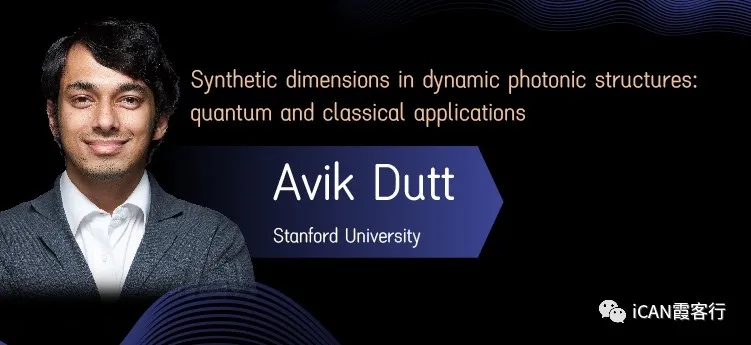
Synthetic dimensions in dynamic photonic structures: quantum and classical applications
动态光子结构中的合成维度:量子和经典应用
Avik Dutt
Stanford University
斯坦福大学
Abstract
Photons are incredibly versatile particles, with multiple degrees of freedom such as frequency, spatiotemporal mode structure, polarization and propagation direction, that can be manipulated by dynamic photonic structures. In this talk, I will show how to harness the manipulation of these degrees of freedom to create synthetic photonic dimensions, for quantum, nonlinear and topological photonics. For this purpose, we use high-quality-factor resonators to enhance light-matter interactions. Specifically, we show how synthetic frequency dimensions can be used to simulate a wide variety of physics related to the quantum Hall effect, such as effective magnetic fields, spin-orbit coupling, spin-momentum locking and topological chiral one-way edge modes. These two-dimensional effects are realized in a single modulated photonic resonator, elucidating how higher-dimensional physics can be implemented experimentally in much lower-dimensional structures. We introduce a method to directly detect the band structures in such synthetic dimensions from time-resolved transmission measurements. This paves the way for quantum simulation and information processing in high dimensions on chip using scalable devices with significantly reduced footprint.
High-quality resonators can also be used for generating ultrabroadband frequency combs – a sequence of narrow equi-spaced lines in the spectral domain. We show how to generate two such combs on a single silicon nitride chip pumped by a single laser for real-time spectroscopy of materials. The same resonators pumped with much lower powers also generate nonclassical squeezed light, with a quantum noise reduction below the standard quantum limit. Using this technique, we report the first nanophotonic source of optical squeezing, which finds applications as a scalable source for quantum sensing and quantum information processing.
At the end I will briefly discuss the potential for extensions to non-Hermitian systems, and to strongly interacting, time-modulated quantum systems.
光子是非常多功能的粒子,具有可由动态光子结构控制的多个自由度,包括频率、时空模式、偏振和传播方向等。在本报告中,我将展示如何通过操控这些自由度来产生量子、非线性和拓扑光子学中的合成光子维度。为此,我们使用高Q值的谐振器来增强光与物质的相互作用。特别的,我们展示了如何使用合成频率维度来模拟与量子霍尔效应有关的各种物理现象,如有效磁场、自旋轨道耦合、自旋动量锁定和拓扑手性单向边缘模式。这些二维效应是在单个调制光子谐振器中实现的,解释了如何在低维结构中用实验实现高维物理。报告中,我还介绍了一种通过时间分辨透射测量直接检测以上合成维度的能带结构的方法。这为在芯片上通过可扩展的设备和较少的步骤实现高维量子模拟和信息处理铺平了道路。
高质量的谐振器也可以用来产生超宽带频率梳(在频谱域上的窄带等间距线)。我们在报告中展示了如何在单个氮化硅芯片上用单激光泵浦产生两个超宽带频率梳,以用于材料的实时光谱分析。
如果我们用功率低得多的激光泵浦同样的谐振器,则可产生非经典的压缩光,其量子噪声可以降低至到标准量子极限以下。利用该技术,我们报道了首个压缩纳米光源,它有望成为量子传感和量子信息处理应用的可扩展光源。最后,我将简要讨论其扩展到非厄米系统和强相互作用、时间调制量子系统的可能性。
Biography
Avik Dutt received the M.S. and Ph.D degrees in Electrical and Computer Engineering from Cornell University, Ithaca, NY, USA, in 2015 and 2017, respectively, and the Bachelor’s degree from Indian Institute of Technology (IIT), Kharagpur, in 2011. He is currently a postdoctoral scholar at Stanford University. His research interests span quantum/nonlinear photonics, silicon nanophotonics, topological physics, synthetic dimensions, frequency combs, and time-modulated/non-Hermitian systems.
Avik was the Editor’s pick for the Outstanding Reviewer for July 2020 in LSA, and is among the Top 1% of Physics reviewers (2018). He was awarded a Jacobs Fellowship (2011) and a Zurich instruments thesis award for his Ph.D. dissertation (2017). He has authored/co-authored more than 30 journal articles in journals such as Science, Nature Communications, Nature Photonics, Light: Science and Applications, Science Advances, PRL, Optica and other OSA, APS, IEEE and ACS journals, which have been cited more than 1000 times since 2015. He was a subcommittee member of the Latin America Optics & Photonics conference (2018) and a session chair for the SPIE Optics + Photonics conference (2020). Avik enjoys communicating science broadly by contributing to Wikipedia and news articles, especially involving projects which increase the representation of women and racial minorities, such as Art+Feminism.
Avik Dutt于2011年获得印度理工学院(IIT)的学士学位,并于2015年和2017年获得康奈尔大学的电子计算机工程专业的硕士和博士学位。目前,他是斯坦福大学的博士后。他的研究领域涉及量子/非线性光子学、硅纳米光子学、拓扑物理、合成维度、频率梳和时间调制/非厄米系统。
Avik曾荣获Light: Science & Applications 2020年7月编辑选择的杰出审稿人,也是2018年物理学排名前1%的审稿人之一。他曾获雅各布斯奖学金(2011年)和苏黎世仪器论文奖(2017年),并在Science、Nature Communications、Nature Photonics、Light: Science and Applications、Science Advances、PRL、Optica和其他OSA、APS、IEEE和ACS期刊上发表了30多篇文章,自2015年以来被引超过1000次。他是拉丁美洲光学和光子学会议(2018年)的小组委员会成员和SPIE光学+光子学会议(2020年)的分会主席。Avik喜欢通过在维基百科和新闻文章中发表文章来广泛传播科学,尤其是涉及到增加妇女和少数民族代表性的项目,如艺术+女权主义。
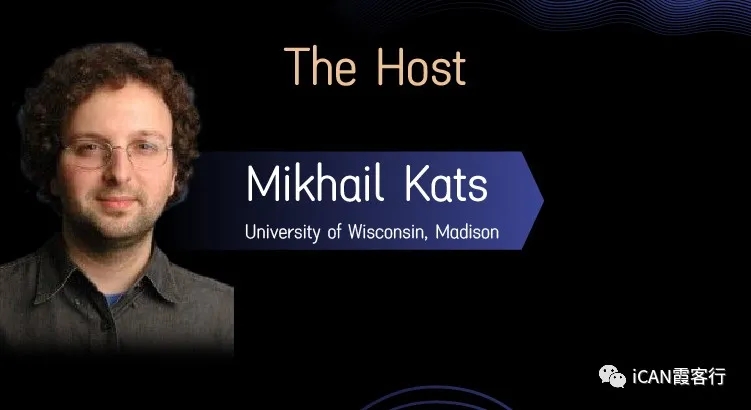
同时,本次讲座还邀请到威斯康星大学的Mikhail Kats教授为大家带来精彩的主持。
每一期iCANX Talks直播结束后,都深受参会者好评,不仅为感兴趣的参会者和读者深度理解相关技术提供了帮助,也为研究生深入开展科研提供了一个很好的平台。更多精彩,尽在iCANX Talks,扫描二维码,关注更多精彩内容吧!

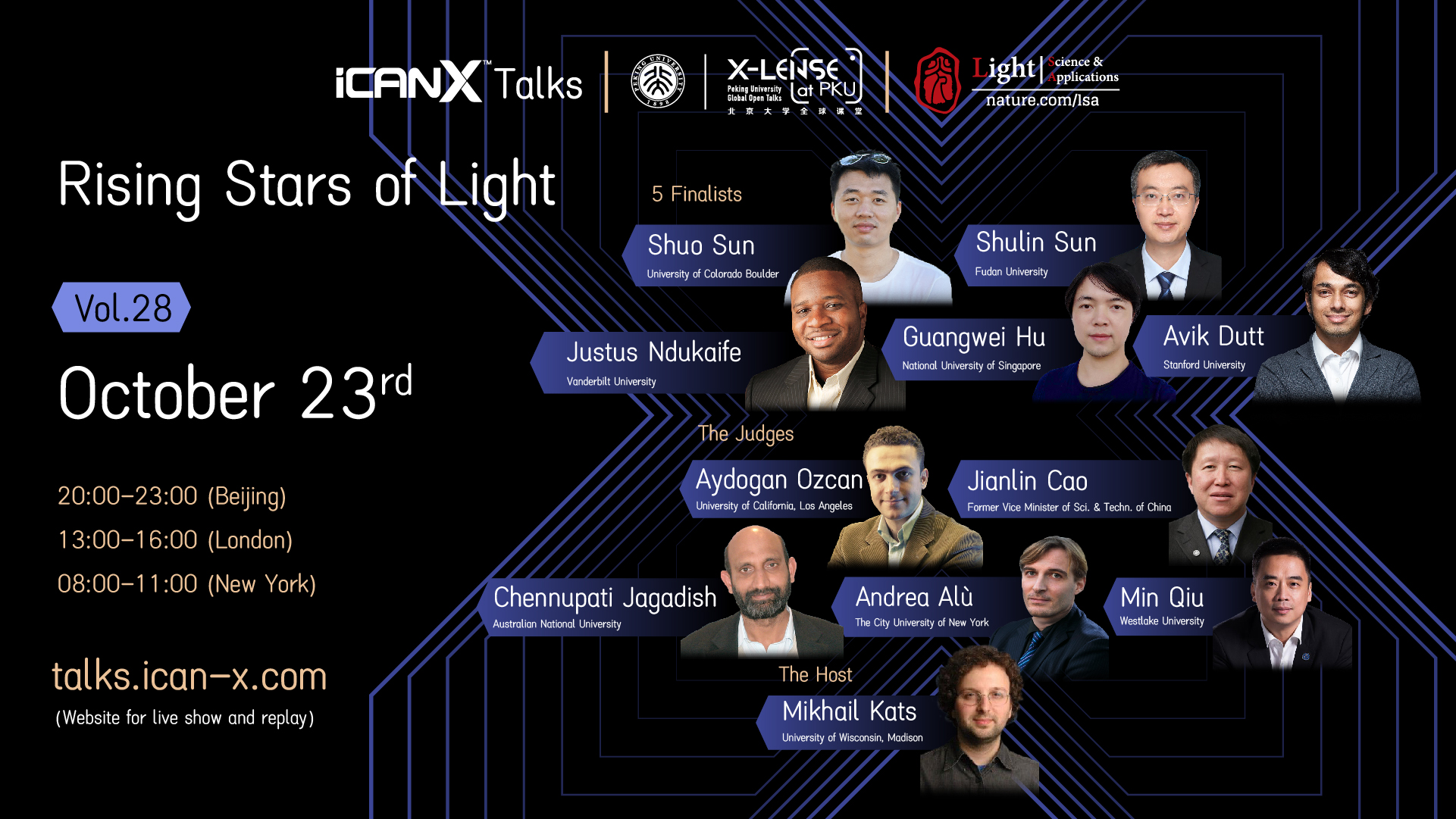
https://m.sciencenet.cn/blog-299-1255331.html
上一篇:最后18小时┃IEEE MEMS2021的征文马上截止啦!
下一篇:张海霞┃根